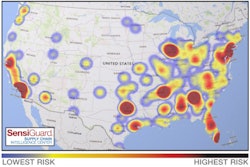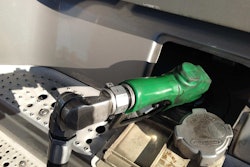Given what seems to be growth in the number of trucking accident nuclear verdicts —verdicts of $10 million or more that do not mesh with the injuries from the incident — it’s become even more important for fleets to make safety a priority.
While there are many strategies and principles you can deploy in a culture of safety, there are six fundamental steps.
 Terry Lutz is vice president of risk management at Transervice Logistics.
Terry Lutz is vice president of risk management at Transervice Logistics.It starts at the top. In order to be effective, the commitment to safety has to start at the very top of the organization. Safety is no longer at the tail end of the line. It now has to be at the forefront of your corporate vision, structure and attitude. Fleet management has to buy into safety first which should then set the tone for the entire organization.
Spec for safety. One way for management to demonstrate its commitment to safety is to invest in safety equipment for its fleet. Lane departure warning systems, collision mitigation systems and forward and rear facing cameras are just some of the things that can be spec’d to make a truck safer to operate. Cameras offer the added bonus of helping you defend yourself in an accident that was not your driver’s fault, or allow you to resolve the matter quickly if the driver was at fault.
Hire right. After you’ve looked at the equipment, the next piece of the safety equation is driver selection. You need to look at their experience and review MVRs and PSPs to see what their record looks like. Given today’s driver shortage, not all applicants will have stellar records. If you have to hire drivers with less than perfect records, remember you will need to train, train, train.
Monitor behavior. Fortunately, today’s trucks have loads of data coming from them so you can see how the truck is being driven. You can get information on speeding, hard braking, stopping and how often the lane departure warning system was activated.
Incentivize safety. Develop programs to reward and/or discipline safe driving behaviors. At Transervice we have an annual safety incentive award program, a quarterly incentive, commendation certificates, a safety scorecard and progressive discipline when needed. The old adage, “What gets measured and rewarded gets done” is very true when it comes to safety.
Keep it fresh. While safety must always be a high priority, you need to make sure to freshen your safety message from time to time to keep people engaged. If you don’t keep it fresh all drivers will hear when you start talking about safety is “whaw, whaw, whaw, whaw.” You need to figure out new ways to get the message across. Your safety incentive programs can help with that.
Terry Lutz has spent most of her career in risk management and spends much of her time working with brokers, underwriters and claims professionals dealing with all lines of insurance including automobile and general liability, workers compensation, commercial property and umbrella.











